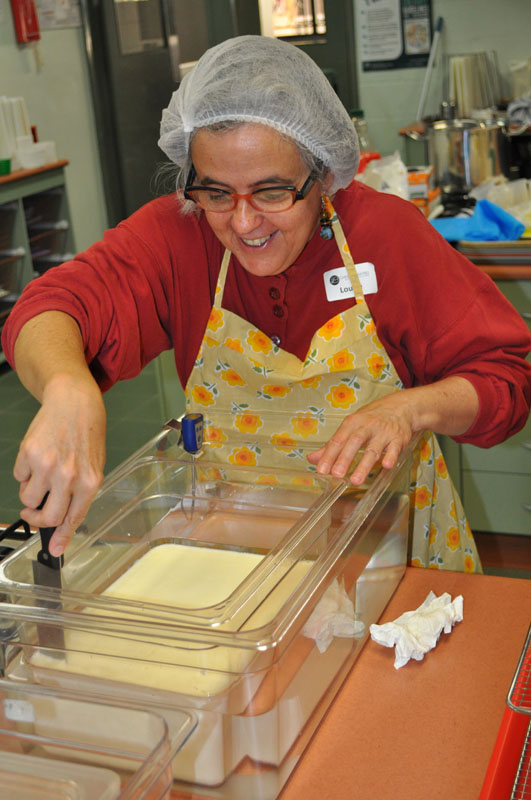This term refers to the process of curd particle contraction and the expulsion of whey (moisture) from the curd. Syneresis is important because the whey contains lactose, which is fermented by the starter cultures to lactic acid and the moisture content of the curd throughout the cheesemaking process dictates the type and quality of the cheese being made. When the rennet is added to the milk to form a curd and the curd is cut, the process of syneresis has begun. You now have curds and whey. The factors affecting the rate of syneresis for a curd particle include:
- Size of cut: There are many ways that curd particle cut sizes are described, e.g. mm or cm or corn kernel or rice grain size. The aim for each cheese is to be true to type is to cut the cheese accurately. The cheesemaking process up to the point that the curd is cut is very methodical, and not much interpretation of the process is required: e.g. warm to a certain temperature, add the calcium chloride, add the starter cultures, and add the rennet. But the next step is cutting the curd, and it is not as straight forward as the previous steps. First, you must exercise judgment to decide if the curd has set. Then if the answer is ‘yes’, you have to cut the curd. There are many different methods and speeds that cheesemakers use to cut the curd. But generally, the larger the cut size, the harder it is to remove moisture out of the curd particle. So, if you have a Grana size particle smaller than a grain of wheat yo will have less moisture and a hard cheese, a Cheddar at 10mm will not be as hard and a Brie at 15mm will be softer again. It is easier to remove moisture from the curd that is wheat size than a 10mm curd and so on.
- Milk Composition: In particular protein (casein) and fat composition. Milk from some breeds, such as Friesians, has lower casein and fat content, and this makes the curd particle softer and more fragile than a curd particle from a Jersey or Guernsey, and movement of the curd during the stirring step can break up the curd, making it fractionally harder to remove moisture from the cheese. Also, milk with a high-fat content from breeds such as Jerseys makes a firmer curd, but that curd retains moisture. That is because curd particles have microscopic channels that the liquids (lactose and water) pass through to exit the curd. The extra fat and larger fat globules of Jersey and Guernsey type cows are able to block those drainage channels, and as a result, you have more moisture remaining in the curd.
- Milk Acidity: Milk with increased acidity (natural or through ripening) shrinks the curds and causes moisture loss. Greater acidity will make you lose moisture more rapidly. This also applies to curd immediately after hooping, where if the temperature drops to below 23c, the rate of acid development slows dramatically. On these cold nights, if you do not keep your cheese warm, your cheese will not reach the desired acidity level and will have excess moisture in your cheese the following day.
- Rate of Acid Development: The steady rate of acid development within the curd is the most important factor influencing moisture expulsion. The rate, not the degree, must be adjusted during manufacture to suit moisture expulsion.
- Temperature: Moisture expulsion increases as temperature increases. Moisture loss is most rapid immediately following cutting after which the rate of moisture loss steadily decreases. Curd particles have an outer casing that holds the content of the curd in place. As stirring and or cooking take place, that casing hardens and gradually restricts moisture flow out of the curd particle. Cheesemakers exploit this by cooking the curd immediately after cutting when making cheese varieties with lower moisture content. As curd is a poor conductor of heat, care must be taken to ensure heating does not happen at too fast a rate as this will result in excessing case hardening of the curd particles. This condition will lead to an overly moist curd particle. In a curd particle where there is moisture, there is also lactose. If you do not remove sufficient moisture at hooping, the remaining lactose will keep fermenting and produce too much acid, especially in the first 12 to 24 hours after hooping.
- Agitation: Stirring curd in the whey reduces moisture content. This effect relies on breaking up clumps and creating a ‘collision effect’ among the curd particles. Stirring is often slow at first, as that is when the curd particle is more fragile. And stirring speed can be gradually increased after that. Dry stirring of curd after whey removal is also effective in expelling moisture. However, excessive use of this technique will result in high fat losses.
- Salting: The amount of salt added to curd is the final method of adjusting moisture content; however, it is only effective in compensating for small differences as it affects curd fusion and cheese quality if too much additional salt is added. If too little salt is added, the cheese’s quality and flavour are compromised. If dry salting, salt should be applied gradually and not in one application. As the whey that comes out of the cheese at the first salting, will ‘wash’ away the salt before most of it can be absorbed into the cheese. If brine salting, I prefer a 20% brine over a saturated brine.
- Pressing: Depending on the cheese type, pressure may be applied at different levels and for varying time periods. Pressing should always be applied slowly to avoid excess fat loss and trapping gases within the cheese. This allows whey to be gradually removed from the curd particle and completes the curd matting process. On colder days the cheese needs to be kept warm during the entire pressing process.
- Ripening of the cheese. If you have completed all of the previous steps as per the recipe, you can be confident that the ripening process will work well for you. The ripening process requires the active bacteria and enzymes to break down the fat, protein and carbohydrates in the cheese. If the moisture level is correct, along with several other variables such as acidity, salt and temperature, the cheese will ripen as required. You should (fingers crossed) achieve a cheese of a specific flavour, texture, body and appearance. But if the moisture level is too high or too low, then a different result can be expected.







